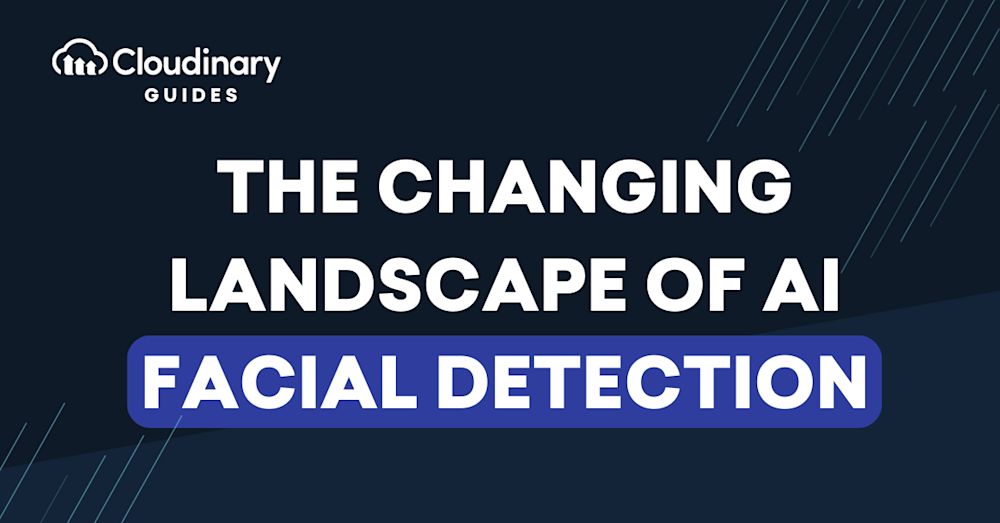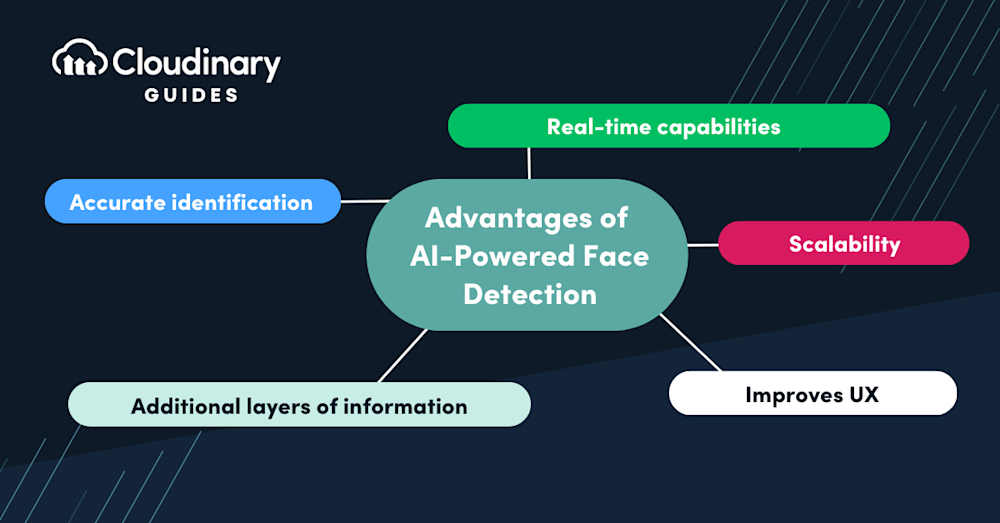Are you intrigued by the advancements in AI facial detection and wondering how it affects your world? This technological marvel has reshaped the digital world, influencing how we interact with our devices and opening up a world of possibilities. As reported by Gartner, the global AI market is projected to soar to a staggering $134 billion by 2025, showing just how impactful this new tech is.
AI-driven facial detection is at the forefront of this transformation, representing a monumental leap in the field. Its use of artificial intelligence to recognize faces has enhanced accuracy and unlocked a host of new applications, making it a game-changer across various domains. In this article, we’ll dive deep into the evolution of facial detection technology, explore the fundamental principles of AI in facial detection and show you how to use it in your projects.
In this article:
- What is AI Face Detection?
- Key Applications of AI in Face Detection
- Advantages of AI-Powered Face Detection
- Challenges in AI Face Detection
- Face Recognition Search Engines
What is AI Face Detection?
AI facial detection, or facial recognition, is a form of technology that leverages artificial intelligence to identify or verify a person by comparing and analyzing patterns based on the person’s facial contours. Early systems mainly used 2D images, but contemporary solutions increasingly rely on 3D models and even live video feeds for greater accuracy and improved dynamic recognition. This technology represents a revolutionary leap forward, harnessing the power of artificial intelligence algorithms to precisely pinpoint and locate human faces within images or video content.
The Role of Machine Learning and Neural Networks in Detecting Faces
At the heart of AI face detection lies complex machine learning techniques, with neural networks leading the charge. These algorithms are trained on expansive datasets, honing their ability to discern intricate facial features, subtle patterns, and variations. This training equips them with the ability to identify faces across diverse conditions and settings with strong confidence levels, much farther than previous methods.
Differences Between Traditional Face Detection and AI-Powered Methods
Traditional face detection methods heavily lean on rigid rule-based algorithms, which are limited in their applications by design. On the other hand, AI-powered face detection takes advantage of cutting-edge advancements in deep learning and neural networks to be more adaptable than these rulesets. This transition leads to substantial improvements in accuracy, versatility, and adaptability, enabling the technology to excel in a multitude of scenarios.
Key Applications of AI in Face Detection
AI-driven face detection has found diverse applications across various industries, revolutionizing how we interact with technology and enhancing several key sectors, such as:
- Security and Surveillance. AI face detection plays a pivotal role in bolstering security and surveillance systems by identifying individuals, monitoring premises, and flagging suspicious activities. In doing so, it ensures areas stay safe and secure without putting others at risk.
- Smartphones. The integration of AI face detection in smartphones has brought about revolutionary features such as face unlocking, secure authentication, and even intelligent photo organization, making our devices more intuitive and secure. It’s also helped with photo and video filters that power many popular apps today like TikTok.
- Social Media. Social media platforms actively employ AI face detection for automatic tagging and photo recognition. This simplifies photo organization, elevates user engagement, and boosts content discoverability.
- Healthcare. Within the healthcare sector, AI face detection plays a critical role in patient identification and emotion analysis. These advancements contribute to more precise diagnostics and the delivery of personalized patient care.
- Retail and Marketing. AI face detection enables retailers and marketers to deliver personalized advertising by analyzing facial features and emotions. This enhances customer engagement and tailors product recommendations to align with individual preferences.
Advantages of AI-Powered Face Detection
AI-powered face detection presents a ton of benefits that have helped it spread like wildfire. One of its biggest strengths lies in the combination of speed and accuracy, allowing it to swiftly and reliably identify faces across diverse environments. Whether in dimly lit settings, crowded spaces, or from various angles, AI-powered face detection consistently delivers accurate identification, providing a robust foundation for its utility.
Additionally, the real-time capabilities of AI face detection make it exceptionally well-suited for applications that demand immediate responses. This responsiveness extends its relevance to areas such as video surveillance, live streaming, and interactive technologies, where real-time performance is essential for seamless user experiences and functionality.
Beyond basic face detection, AI algorithms offer enhanced capabilities by providing valuable insights into aspects like emotions, estimated age, and predicted gender. These additional layers of information enrich user experiences and contribute to comprehensive analytics, further expanding the potential applications of AI face detection.
Scalability is another key advantage of AI face detection, as it can efficiently process vast datasets of images and videos. This scalability makes it suitable for a broad spectrum of applications, ranging from security and facial recognition to content moderation.
Challenges in AI Face Detection
While AI face detection holds immense potential, it is accompanied by several significant challenges that must be addressed. The largest issue revolves around privacy and data security. The deployment of AI face detection systems has raised valid concerns regarding the protection of personal information and data security. To mitigate these concerns, there is an urgent need to develop and implement robust protocols for handling, storing, and controlling access to sensitive data, ensuring that personal information remains shielded from unauthorized access.
Another critical challenge is the need to address biases that may inadvertently affect AI algorithms, potentially resulting in inaccurate or unfair outcomes, particularly with respect to ethnicity and gender. Effectively combating these biases necessitates the cultivation of diverse and representative training datasets. The likelihood of discriminatory or skewed results can be significantly reduced by training AI models on data that mirrors human diversity.
Additionally, achieving consistent accuracy in face detection across various ethnicities and under different lighting conditions is a persistent challenge that requires ongoing refinement and testing of AI models. The pursuit of universal applicability, where face detection reliably performs across diverse ethnicities and lighting environments, demands a continuous commitment to improvement and adaptation. This dedication is essential to ensure that AI face detection remains equitable and effective for all users, regardless of their backgrounds or environmental conditions.
Getting Started with AI Face Detection in Cloudinary
AI-powered face detection is a powerful capability that you can easily integrate into your applications using Cloudinary’s platform. Let’s look at an overview and code snippets to help you get started with AI face detection in Cloudinary.
If you haven’t already, sign up for a Cloudinary account. You’ll need your account credentials for authentication in the code snippets.
Next, let’s create a simple Python project and start by installing the Cloudinary library using pip:
pip install cloudinary
Now, you can upload an image to Cloudinary using the Cloudinary console or their APIs. Start by importing the cloudinary library and configuring the API:
import cloudinary
from cloudinary import uploader
cloudinary.config(
cloud_name="your_cloud_name",
api_key="your_api_key",
api_secret="your_api_secret"
)
Replace “your_cloud_name“, “your_api_key“, and “your_api_secret” with your actual Cloudinary credentials. Let’s upload the following kitchen-bar.jpg image located in the Assets folder of our project:
Now, simply call the uploader function with your image to upload an image:
response = uploader.upload("./Assets/couple.jpg", gravity="adv_eyes", height=40, width=100, crop="thumb")
print(response)
Here, the gravity parameter is set to adv_eyes, indicating that Cloudinary should focus on the eyes when cropping the image. We’ve also specified the width and height parameters to define the new image’s dimensions. Finally, the crop parameter is set to thumb, instructing Cloudinary to crop the image in a thumbnail-like fashion. Here is what our image looks like:
Similarly, we could also leverage Cloudinary’s AI to detect faces by simply changing the gravity parameter to adv_face:
response = uploader.upload("./Assets/boy-snow-hoodie.jpg", gravity="adv_face", height=100, width=100, crop="thumb")
With this, you’re now ready to start detecting faces in images using AI with Cloudinary. You can check out some more in-depth information in the Cloudinary documentation.
AI Face Detection Applications
Beyond the AI face detection capabilities inherent to Cloudinary, there are a multitude of external applications and services harnessing AI face detection, such as:
- Cameralyze – Cameralyze serves as an AI-powered video analytics platform, proficient in leveraging face detection for an array of applications. This technology finds applications in surveillance, crowd analysis, and security enhancement.
- Phototeca – Phototeca, a photo management application, deploys AI face detection to facilitate automatic photo organization and tagging based on recognized faces, streamlining the photo management process.
- Cloud Vision API – Google’s Cloud Vision API offers a robust suite of AI face detection capabilities for a wide spectrum of applications, including image labeling and sentiment analysis.
- Google Photos – Google Photos incorporates AI face detection to simplify image management, aiding users in categorizing and searching for images featuring specific individuals.
Face Recognition Search Engines
So, we’ve seen what Cloudinary can do when it comes to AI facial detection. But it’s just one player in a larger game. There’s a whole world of face recognition search engines out there that are changing up how we find and interact with images online. Let’s take a look at some popular ways to search the web using AI facial recognition.
Social Catfish
This savvy tool uses AI facial recognition to help users verify the identity of people they’ve met online. By running an image through their expansive database, Social Catfish can cross-check photos across numerous platforms and social networks. Increasingly appreciated by savvy internet users, it lessens the chance of being duped by a false online persona. Essentially, their AI tech sinks its teeth into the expansive web, reeling in data from far and wide, making it much easier to verify if the ‘big fish’ you’ve caught online is genuine.
PimEyes
PimEyes is an advanced face search engine that offers a spectrum of facial recognition capabilities. Its primary function revolves around locating images containing specific individuals, making it a valuable asset for personal branding, privacy control, and online reputation management. This makes it a great tool for personal branding, privacy control, and online reputation management.
TinEye
While primarily an image search engine, TinEye also offers facial recognition capabilities.
It equips users with the ability to locate instances of a specific face within online images. This proves invaluable in tracking image usage across the internet, making it an incredible tool for web developers, content creators, and copyright holders.
Final Thoughts
The advent of AI in the field of face detection, including its seamless integration with powerful platforms like Cloudinary, has been nothing short of revolutionary. These developments hold significance across various industries, spanning security, privacy, personalization, and content management. The accuracy and speed with which AI, when combined with platforms like Cloudinary, can identify and analyze faces have opened doors to innovative solutions that were once the stuff of science fiction.
As we move into the future, AI face detection continues to advance, showing that the future of AI face detection holds exciting prospects. We can anticipate even greater accuracy, versatility, and ethical considerations in its applications like healthcare diagnostics, enhanced customer experiences, and heightened security, especially when harnessed through platforms like Cloudinary.
Learn more:
Facial Recognition Surveillance System For Restricted Zones




